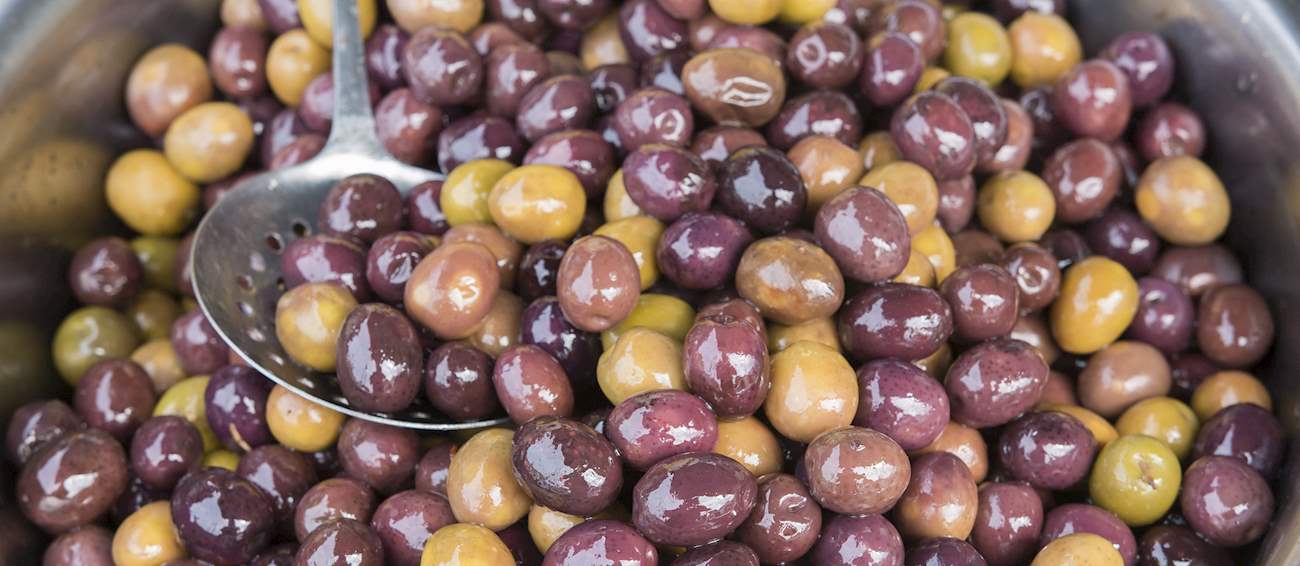These olives are cultivated in the province of Amario in Rethymnon prefecture on the island of Crete. The Mediterranean climate and fertile soil on the island provide excellent conditions for olive growing. These Throuba olives fall on the ground when fully ripe, and they are collected using olive nets.
They are characteristically black in color and have a meaty texture. They are not bitter because these olive trees are infested with the Phoma oleae fungus, which causes the olives to lose their bitterness as they ripen on the tree. Besides selecting the best olives, no further human processing is required.
This table olive grows on olive trees of the Konservolia variety in the province of Volos in the Thessaly region. This region has a Mediterranean climate with dry summers and mild winters that are suitable for the cultivation of olive trees. The olives are harvested by hand, either while they are still green or when they are fully ripe and purple-black to black in color.
They are transferred to a processing plant where they are treated with caustic soda if they are ripe or a salt solution while still green, and then pickled. The flavor of these olives can be described as fruity and pleasantly sweet. The best way to serve Konservolia Piliou Volou is alongside delicious cheeses or sliced over salads.
This table olive is obtained from olive trees of the Konservolia variety grown in the municipal areas of Peta, Komboti, Grammenitsa, Vlama, Sykies, Sellades, Makryniada, and Kommeno in the Epirus region. The weather and soil conditions in these areas are not ideal for olive cultivation, but this variety has adapted well to wet soils and cold winters.
The olives are harvested manually and transferred to a processing plant, where they must pass a quality control check. The best olives are placed in containers with brine to ferment. The fermentation process lasts from 20 to 60 days for green olives and four to five months for yellow and black olives.
This table olive is obtained from olive trees of the Konservolia Amfissis variety grown in the municipalities of Amfissa, Itea, Delfi, Chrisso, Sernikaki, Aghios Konstantinos, Aghios Georgios, Eleonas, Drossochori, Prossilio, and Kirra in Phocis prefecture.
Even though conditions in this mountainous region are not ideal for cultivating olives because of its cool winters, the Konservolia variety has adapted well. The olives are usually harvested when fully ripe and gathered by hand using small wooden sticks.
The island of Thassos has been known for its olives since ancient times. The famous Thassitiki olive of the Throumba variety was even named after this island. These olives are harvested from early November through mid-January, when they become fully ripe or even overripe and develop their distinct black color.
Due to the presence of the Phoma oleae fungus, Throumba olives lose their bitterness while ripening and can be eaten straight from the tree. The olives are primarily picked by hand in order to avoid any bruising of the fruit. After picking, they are washed in mountain spring water, graded by size, and cured in coarse salt.
TasteAtlas food rankings are based on the ratings of the TasteAtlas audience, with a series of mechanisms that recognize real users and that ignore bot, nationalist or local patriotic ratings, and give additional value to the ratings of users that the system recognizes as knowledgeable. TasteAtlas Rankings should not be seen as the final global conclusion about food. Their purpose is to promote excellent local foods, instill pride in traditional dishes, and arouse curiosity about dishes you haven’t tried.





